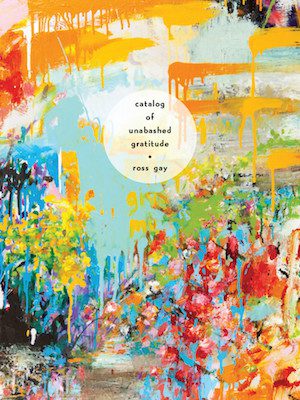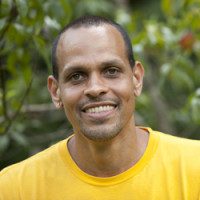After well-deserved accolades, Ross Gay approaches the lectern at Cave Canem July 9, 2015 in Brooklyn. But before even greeting us, he looks down, saying “I’m going to empty my pockets…” which he then proceeds to do. It’s a throw-away remark, but one that tells everything about Gay, who gives so fully, offers us dear readers everything from the lint to the coin—holds to the light every memory and dream space, each quotidian gesture, the smallest weeds of this breathing world. This is a poet of deep generosity, for whom every fig tree is a communion table.
Ross Gay is in New York to read from his new book Catalog of Unabashed Gratitude (Univ. of Pittsburgh Press, 2015), a collection of odes and long poems that are sprawling and raucous and gorgeous, with turn after associative turn. It is the night before his reading and a few dozen of us are gathered to hear the poet speak on the role of seeing in the visual and literary arts and its connection with the imagination. A broad topic, for sure, but the very title, “Fall No More,” invites curiosity.
It’s clear from the start that this will be more meditation than lecture, as Gay struggles to even frame the complex concerns he seeks to address: violence to the body, portrayals of violence and the residue it leaves, racism, the relationship between the beholder and the beheld. This exploration, this roundabout way of figuring can best be held by poem, not prose, says Gay, as poems can “sustain the ways of knowing or not knowing.”
We, the audience, follow his mind’s path, its bee-like flight, as Gay reads from three unfinished works in progress. And though the pieces differ widely in their form and content, tonight’s talk is fundamentally concerned with love. Love as an antidote to violence. Asks Gay, “is there a way of looking that is a kind of holding, a kind of loving?”
The first piece he reads (a self-described “failure,” more on that later) is a lengthy description of a series of proposed photographs in which every single African-American wears orange, blaze orange. Hunting colors, he says, though they won’t be carrying weapons. He envisions a variety of scenarios in anywhere USA, a group of picnickers, an old lady crossing the street. There would be categories like Nature with a person in a blaze orange jumpsuit against the “stark endless white of Antarctica;” photos in aquatic settings, including one image of a hundred children floating in blaze orange life vests, “the ship just out of the frame.” A highly acclaimed writer in a fabulous gown receives an award with an orange shawl draping her shoulders.
Gay stops with an image of a child hiding his face behind an orange-gloved hand. The story is haunting in its documentarian tone and dystopian feel, though arguably it portrays current times. But the message is unmistakable: there is no blending; color trumps individuality; the color of safety has become the color of danger.
 His next piece is from the draft of a long poem, which starts with an invocation to “follow me into a dream,” a dream that begins with basketball—Kareem Abdul Jabar and a child’s flat-out worship of the man “like I was at the foot of banyan tree… I was weeping.” Gay then moves to the marvelous athleticism and grace of Julius Erving and the famous game which culminated in a never-before-seen scoop shot that would become Dr. J’s signature move and forever change basketball.
His next piece is from the draft of a long poem, which starts with an invocation to “follow me into a dream,” a dream that begins with basketball—Kareem Abdul Jabar and a child’s flat-out worship of the man “like I was at the foot of banyan tree… I was weeping.” Gay then moves to the marvelous athleticism and grace of Julius Erving and the famous game which culminated in a never-before-seen scoop shot that would become Dr. J’s signature move and forever change basketball.
But at this apex of human accomplishment, when even gravity seems superfluous, comes a disturbing turn: “When Doc is suspended here in flight, Kareem’s hands no longer look like the flimsy limbs of silver maples, but like a person preparing to catch a falling body which according to my country, I fear, I believe, is a synonym for a black person.” Slam: we have left the dream. The hero, the metaphor has turned back into a body, and we are in the year 2015, the year of falling black bodies. And who will catch them?
Then another ghastly leap (literally) in the poem: now we are in a museum, in a gallery of famous war photographs. And there between the well-known Viet Cong soldier being executed at close range and the napalm-doused fleeing girl is another famous photo of two black people falling from a collapsed fire escape on Marlborough Street in Boston (a young woman and a small child). Gay struggles to find the right language for these two plummeting bodies. But what has him transfixed is the child, whose face seems to look almost directly into the camera, “which is to say, she sees herself somehow being seen falling to her death …held like that, unlovingly by the camera.” He notes that the language of photography can be violent, with verbs such as “shoot” and “capture.”
His last piece of the evening elaborates on issues of portrayal, the relationship between the subject and the object and the difference that relationship makes to the viewer or reader. He mentions a particularly poignant scene in Charles Burnett’s film My Brother’s Wedding, where a father and son are wrestling as the mother watches. Of Carrie Mae Weems’s work, he is most moved by a picture of a domestic scene, one that is almost banal but clearly portrays the love between the beholder and the beheld.
The poet Jena Osman once duct-taped a camera to a mop handle and thusly held the camera at the eye level of various public monuments in Philadelphia to “see” what they saw. Asks Gay, “what might our poems leave behind as a record of our seeing? What kind of eyes does your poem have?”
Sight is a very deliberate choice by an artist, “a discipline for which muscles can be developed,” says Gay. And this is how poetry derives its power, its agency, by the ways it can direct the eye. But the poet has a different toolkit from a visual artist. The world of a poem builds incrementally: it grows, it accretes. While an individual line can have shock value, it is nearly impossible to create the same visceral impact as one quick glance at the collapsed fire escape photo, the impromptu postures of those bodies in freefall. When Gay describes that photograph with words, he moves us through it slowly, with intention, directing our eyes also to the loveliest things he can find amidst the disaster, the smallest details. There is a potted plant and a neatly-tied saddle shoe. Regarding the woman: “a forearm and hand elegantly drawn into what might be a wave but is not…a child falling, splayed exactly unlike a bird.”
Even more fundamentally, Gay has gotten us here through another route, through basketball—with supple magic flying bodies, defying earthly bounds, delighting the crowd: Oh, what a piece of work is man! This is the room we first pass through on our way to Marlborough Street.
In the title poem of his new book, he writes, “Here is a cup of tea. I have spooned honey into it.” This is how the poet takes his truth, how he gives it to us, like lightning to the children eased. In the poem “Spoon” (dedicated to Don Belton), only near the very end of the poem do we read that Don was murdered. We are not shown the corpse but the living man, the anecdotes and casual intimacies that comprise a friendship and a life. The poem begins with the “ornate tendrils of ivy” of a metal spoon. And sweet potato biscuits.
The poet can be spotted elsewhere in this poem, in another guise, as “a hollering man / at the market who wears a rainbow cap / and dances to disguise his sorrow.” Here again in “Spoon,” Gay writes, “I swore when I got into this poem I would convert / this sorrow into some kind of honey with the little musics / I can sometimes make with these scribbled artifacts / of our desolation.”
When someone in the audience asks why Gay considers the first piece (about the blaze orange) a failure, he says because it “remains in a state of terror. It doesn’t get us out of it.” This suggests that a work of art, crafted by the artist’s eyes, has the power– and the responsibility– to redeem, to catch the bodies. Gay seems to be saying that if we are moved to love others, to see them with love, then violence is unthinkable.
“How can I see such that there is no more falling?” Ross Gay wants to know.
***
Ross Gay’s next stop is the Radcliffe Institute, where he was chosen as a fellow for the 2015-16 year. A poet and gardener, Gay is working on a long piece entitled “Black Georgics” after Virgil’s seminal work on agriculture and how humans relate to the natural world.




